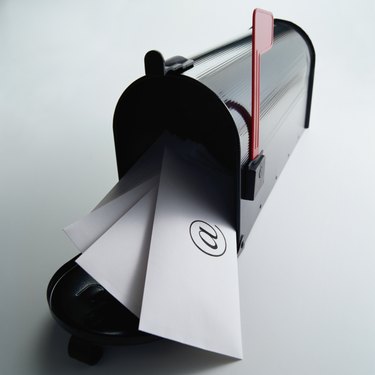
In some circumstances — such as when you're away from the office but need to check your email, or when you're juggling multiple email accounts — Microsoft Outlook uses a set of commands called rules to forward or redirect incoming messages automatically. Mail forwarding and redirection can also be applied to single messages without creating a rule.
Rules
Video of the Day
Outlook uses program commands, known as rules or filters, to help manage email, organize messages and stay on task. The built-in Rules and Alerts Wizard enables users to specify conditions upon which Outlook will automatically perform one or more actions or tasks. Popular rules include moving messages from a particular person into a designated folder, flagging messages from a certain sender for follow-up and sending a mobile alert upon receipt of an email containing certain words. Among the user-created rules are commands to automatically forward and redirect incoming messages.
Video of the Day
Forwarding
When email is forwarded, an "FW:" appears at the beginning of the subject line and by default, the body of the email contains the original message and the message's history details. The original message remains in your inbox or its designated folder. Create a rule to automatically forward messages from or to a particular account if certain information is regularly shared with coworkers or other parties and you wish to make it known that you are part of the message history. For example, an assistant in charge of coordinating weekly lunch meetings might set a rule to automatically forward emails from the company caterer containing the word "invoice" to the accounting department.
Redirecting
A message is often redirected when it is received in error. The main difference between forwarding and redirection is that while forwarding automatically makes changes to your email and includes details about the message history, redirection discretely sends the email to the intended party in its originally written state, making it appear as if it was received directly from the original sender. This is a helpful feature if the intended party does not need to know you received the email. For your records, redirection also leaves a copy of the message in your inbox or in the designated folder. Set a rule to redirect mail automatically if you regularly need to reroute messages to other parties. For example, a college graduate, who still receives messages sent to his school's email account might set a rule to redirect mail automatically to a new email address.
Considerations
Sometimes senders use Information Rights Management, a Microsoft option that places permissions on email messages, keeping recipients from forwarding, redirecting or sharing the message in other ways. It is best practice in these cases to notify the sender that you are not the intended recipient, in the event you received the email in error. The sender may remove or alter the permissions, or they may resend the message themselves. Also, for those forwarding a message, especially if the email contains sensitive data, rerouting the mail to an address outside of your company's network may violate internal policies and privacy laws.